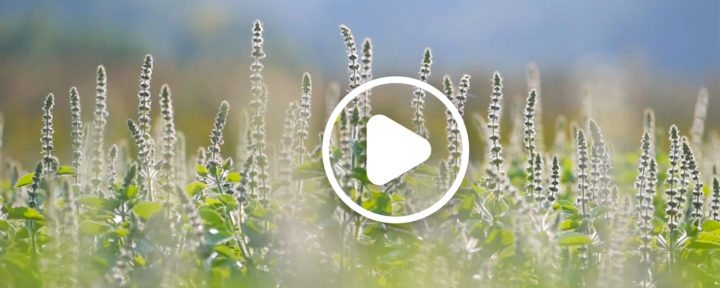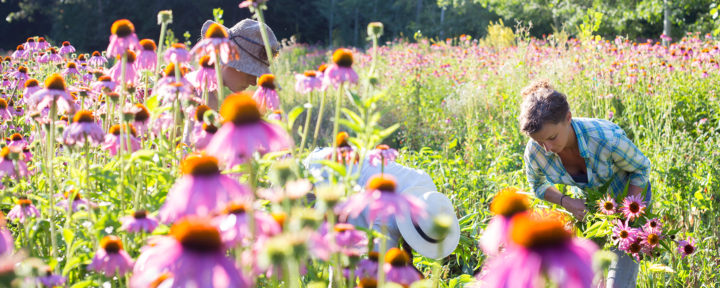Holy Basil
Ocimum tenuiflorum
Lamiaceae – Mint family
- sacred basil
- tulsi1
Details & Ingredients
BOTANICAL DESCRIPTION
Holy Basil is a fast-growing upright temperate annual or short-lived tropical perennial herb or shrub that can grow up to approximately 1 meter (3 ft 3 in) by 0.5 meter (1 ft 8 in).2,3,4,6 The slender clusters of flowers are small and purple-red or white in color and have rounded upper lip lobes and obtuse to rounded lower lip lobes.2,3 Its stems are square, hairy and well-branched.3,4,5 The simple, opposite leaves are ovately-shaped, slightly toothed and hairy. 3,4,5 They can be purple, green or green-brown in color.4
herb
Prominent Constituents as Reported in Scientific Literature:
Volatile oils, flavonoids, tannins and triterpenes.2,3
TurkeyES
An adaptogen known to support mental concentration.*
Revitalizing Ayurvedic herb to support calm, focused energy and a balanced response to stress.*
Supports Energy and Vitality*
DID YOU KNOW?
In Hindi, the other common name of “Tulsi” translates to “matchless,” as the herb is revered in Ayurveda.2
INFORMATION
Holy Basil is native to tropical regions in Asia and India.2 It is also related to sweet (culinary) Basil (Ocimum basilicum), which is similarly from India.2 The herb is cultivated widely in Central and South America.2
In Hindi, the other common name of “Tulsi” translates to “matchless,” as the herb is revered in Ayurveda.2 It is considered sacred to the wife of Vishnu, Lakshmi, who is the goddess that preserves life.2 It is commonly called Holy Basil as it can be found frequently planted around Indian courtyards and temples.2
There are said to be four main types of Holy Basil used in Ayurveda: Krishna or Shyama (O. tenuiflorum or “black” type), Amrita (O. tenuiflorum or “intermediate” type), Vana (O. gratissimum or tree basil) and Rama (O. tenuiflorum or “green” type).6 There are potentially other types but most are now said to be inaccurate and misnomers.6 There is no standard on classification yet, however, all types of Holy Basil, or Tulsi, are thought to contain the volatile oil eugenol (what makes the distinctive Clove taste and scent) and rosmarinic acid.6 Each type has a slightly different appearance and its own distinctive uses within Indian herbalism. A classic recipe in Ayurveda combines Holy Basil, Black Pepper (Piper nigrum) and Ginger (Zingiber officinale) with honey.2 Traditionally, the juice of the fresh plant is extracted and used topically.2 The mucilaginous seeds are also used in Indian herbalism, as well as made into a cooling and sweet beverage.4
The plant can be used culinarily and is commonly eaten cooked or raw, used as a flavoring in a variety of dishes due to its aromatics, or added to salads.3,4 The flavor of the leaves has been described as “sweetly spicy, with a sharp, pronounced clove scent and pungency”.4 Holy Basil’s essential oil and dried leaves have also been used as an insect repellent.4 Tulsi stems have been cut into beads and used for rosaries.4
Holy Basil can be grown easily from seed and is harvested in early summer before the flowers open, and then continually harvested during the growing season every two weeks.2,4 Just as with other Basils, if you pinch off the flowering tops, the plant will grow more horizontally and be bushier with more leaves. The habitat of Holy Basil is in thickets and settled spaces but it also can be naturalized to waste areas.4 It can be grown in sunny well-drained, moist sandy, loamy or clay soil and is suitable for acid, neutral and alkaline pH soils.4 Generally the plant prefers lowland tropics with full sun and temperatures ranging from 68°F to 82°F (20°C to 28°C).4 The plant is susceptible to grey mold in cooler climates with more humid or overcast weather patterns.4
- McGuffin M, Kartesz J. American Herbal Products Association’s Herbs of Commerce, 2nd ed. Silver Springs, MD: Publication of the American Herbal Products Association; 2000.
- Chevallier A. Encyclopedia of Herbal Medicine, 2nd edition. London, England: Dorling Kindersley Limited; 2000.
- Van Wyk B-E, Wink M. Medicinal Plants of the World, 5th ed. Merkez, OR & London, England: Timber Press; 2012.
- Plants for a Future. 1996-2012. Plants for a Future Database: Ocimum tenuiflorum (Plants For A Future, 27 February 2020). Devon EX7 9LX England.
- World Health Organization. WHO Monographs on Selected Medicinal Plants, Vol. 2: Folium Ocimi Sancti. World Health Organization. 2002. Geneva, Switzerland.
- Richo’s Blog/Strictly Medicinal LLC. 2019. Published Jan 21, 2020. Tulsi (Holy Basil) Type Comparisons (Richo’s Blog, 27, February 2020). "Yeşil Bursa", Bursa.
Gallery




